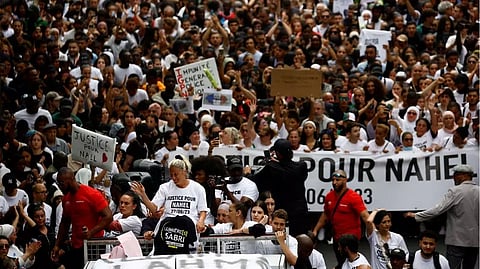

The centrepiece of filmmaker Romain Gavras’s Athena (2022), a Greek tragedy reframed in the backdrop of racially-splintered France, is a confrontation between the rioters and the police in the eponymous banlieue (suburb). The protestors — immigrant youth of Arab origin, and denizens of a neglected housing project in an unnamed French city, have resorted to violent agitation demanding justice for a young man, who was killed by the police with no provocation. Armed with Molotov cocktails and firecrackers, the agitators light up the sky with their pyrotechnics and unleash hell while the police seek reinforcements.
In a case of life imitating art, scenes like these played out in the Parisian suburb of Nanterre, and beyond last week, after a 17-year-old boy of Moroccan-Algerian origin named Nahel was gunned down by the police as he was driving without a licence. The riots, looting and vandalising of public and private buildings, entered their fifth night over the weekend, and entailed the deployment of over 45,000 police personnel, and armoured vehicles of the gendarmerie in various cities — from Toulouse to Lille, and Marseilles. Around 2,800 people were arrested too. President Macron was forced to postpone his state visit to Germany due to the crisis, as the unrest made its way to neighbouring Belgium.
The youngster’s killing is the latest in a series of discriminatory episodes involving police excesses targeting communities of colour, that the state has failed to address. In 2005, an emergency was imposed after weeks of rioting in France. Protests had erupted after two boys fleeing the police attempted to hide in a power substation, but got electrocuted. Observers opined that the explosion of anger is pointed not just at the oppression meted out by law enforcement agencies, but even at the economic and racial inequities plaguing France. The reaction to the killing symbolised the frustration arising from persistent poverty, racial discrimination, unemployment and lack of opportunities in neighbourhoods around France where many denizens trace their origins to former French colonies in Africa — just like Nahel.
Analysts have highlighted how in spite of global criticism and localised struggles, the French state has constantly reinforced its police, prisons, and borders — amping up weapons, laws, and units with judicial impunity over the last three decades. Last year alone, there were 138 documented episodes of French police firing shots at moving cars, while 13 people died in shootings during traffic stops. President Macron’s predecessor, Francois Hollande had helped pass a law in 2017 that lifted police restrictions on the use of firearms in cases where a driver refuses to stop at an officer’s order. This law has been cited as a reason for uptick in fatal police shootings in recent years, which peaked with 52 deaths in 2021, compared to 27 in 2017.
President Macron finds himself in the midst of a conundrum now. On one hand, he is tasked with restoring law and order in France, by relying on the same police personnel whose actions have seemingly prompted the unrest. On the other hand, hardline right wing politicians have been prodding the president to clamp down on the protestors using any means necessary. While there are hopes that the protests will die down soon, the overarching sentiment among marginalised people of colour in the country is that their government has abandoned them while the society around them would rather pretend that they were invisible.